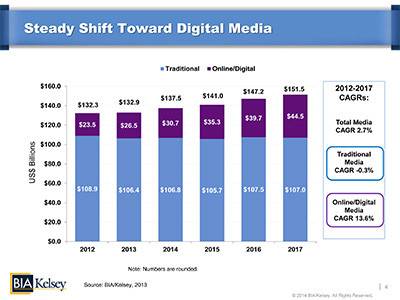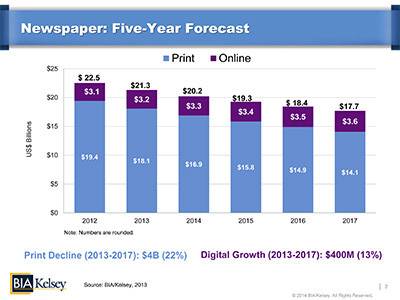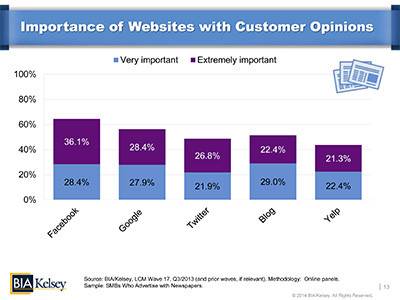BIA/Kelsey execs offer actionable ideas for sales transformation

During the closing session of the Key Executives Mega-Conference, two executives from BIA/Kelsey walked attendees through a look at what small- and medium-size businesses are doing in the digital marketplace and offered actionable ways that newspapers can claim some of the growing dollars being spent in this space.
Charles Laughlin, senior vice president and managing editor, and Jed Williams, vice president, consulting and senior analyst, used five-year forecasts to highlight areas that offer opportunities for newspapers.
The reason SMBs are moving into digital, Williams told attendees, is that their customers are moving that way.
In the graph below, the compound annual growth rate that BIA/Kelsey is forecasting for traditional media is holding fairly steady (shown below in blue); growth opportunities (shown in purple) are in online/digital. Williams said he and Laughlin aren't predicting that traditional media is going away, but said that growth and incremental new revenue is going to come from digital. And, that growth is going to accelerate over the next five years, Williams said.
 |
In the following graphs, Williams offers a five-year forecast for newspapers, showing print advertising decline, but digital growth.
 |
And, a five-year forecast on mobile local ad dollars, which he says newspapers aren't capturing enough of:
 |
The reason why dollars are changing is because your customers are changing, Williams said. "Their needs are changing because their customers' prospects and needs are changing. ... Thus, they are migrating to newer forms of digital media."
"Their demand for ROI is higher than ever," he said. "If the ROI picture is not clear and demonstrable for them, they're gone."
Williams then looked at newspapers' existing customers among SMBs, saying they need to figure out how to optimize those relationships.
He said, "Your customers are pretty progressive. They are actively using digital. They are actively looking to increase their investment in digital ... and they value their relationship with you, which opens the door for you and your sellers to come in, think and work with them in a different way to solve some of these digital ROI problems."
He cited the following media being used by SMBs that already are advertising with newspapers:
- Websites, nearly 70 percent
- Facebook page, 63.9 percent
- Direct mail, 48.6 percent
- Email marketing, 42.6 percent
- Sponsorships, 38.3 percent
- Radio, 37.7 percent
- Google (any Google site), 36.6 percent
- IYP, 35.5 percent
- Video website, 34.4 percent
- Twitter, 32.8 percent
- Giveaways, 32.2 percent
The budget that these SMBs are willing to spend on digital will jump "fairly significantly," Wiliams said – from 25.9 percent to 30.2 percent over the next 12 months.
The place BIA/Kelsey sees a lot of opportunity is in what he called "non-advertising" – "everything in the bucket that's not pure advertising." For example: website presence, online visibility, digital identity, reputation management, social media marketing, search engine optimization, content marketing, etc.
The chart below shows shows of the channels that Williams identified as very important or extremely important to SMBs:
 |
"These are kinds of places that you have to be assisting and facilitating for them – not just with advertising services," Williams said.
He also cited the gap that exists between some of the most widely used digital media and the ROI that SMBs report. For example:
- Email marketing ranks #3 among the most widely used channels, but is viewed as 22nd in ROI.
- Facebook ranks #1 among most widely used channels, but is viewed as 23rd in ROI.
- YouTube is 28th in ROI, although video is in the top 10 in usage.
- Twitter is 35th in ROI, but also in the top 10 in usage.
"You get the idea," he said. "There's an ROI problem here." This offers newspapers an opportunity, he said, to step in and consultatively help them solve this problem.
In addition, 50 percent of newspaper's existing customers already pay a third-party or outside vendor to help them with their online presence, Williams said. "I interpret this two ways," he said. "And, both of these – I think – are opportunistic for you."
- One: Fifty percent of the market already understands the need. You don't have to completely educate the market.
- Two: For the 45 percent that aren't already using an outside vendor, why not you? (Another 5 percent responded "not sure" when asked if they were using an outside vendor.)
He also noted that SMBs report that the premise salesperson still matters to them. Twenty-four percent said this person is extremely important; 22.4 percent, very important; and 21.9 percent, somewhat important.
Laughlin focused on common traits of successful sellers and offered a series of actionable ideas for sales transformation.
Leadership must commit, Laughlin said, beyond lip service:
- They don't let underperformers stick around.
- They gather data – and listen to what it tells them.
- They use robust tools.
- They measure what matters.
Actionable Idea: Accountability
- Performance Accountability Agreements hold reps to increasingly challenging milestones. They need to hit those performance standards or leave.
- Example: Only one sale required in the first five weeks – "Just to prove they can close." Later, it's one sale a week.
- Lesson: Systematically move underperformers out. No one should be surprised when it's time to go.
Actionable Idea: Incentives
- Save the premium leads for sellers. Use appointment setters for lead qualification – their services are valuable to reps. So the reps who are making sales get access to the appointment setters.
Actionable Idea: Measurement
- Let the data tell you what to do. Rely heavily on data to manage your inside sales force. A key mantra: optimize metrics that drive to close.
- Example: Maximizing dials per day increases close rates.
Actionable Idea: Compensation
- If your legacy reps carry digital, make it impossible to achieve their income goals without selling digital.
- Example: At LocalEdge, legacy reps face seeing their bonuses halved if they don't hit their digital numbers.
- Lesson: Legacy reps will often default to their comfort zone – don't let them.
Actionable Idea: Selling
- Competitive audits, powered by assessment tools like Buzzboard or AdMall, get prospects' attention. Is their digital presence at par with their competition? Do they have an opportunity to move ahead of the pack?
- Lesson: Businesses react if they fear falling behind their competitors.
Download the PowerPoint presentation in PDF format





